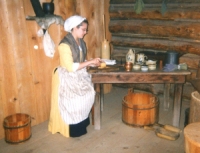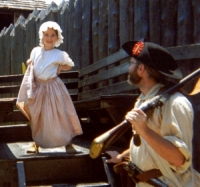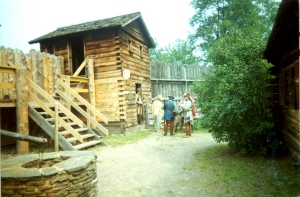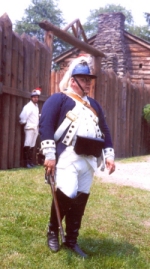Fort Delaware is an authentic depiction of the life of the Delaware Company Pioneers who settled in the Upper Delaware Valley in 1754. A tour of the facilities includes demonstrations of early settlers' lifestyles and craft-making. This facility is located within the Upper Delaware Scenic and Recreational River, a unit of the National Park Service.
Fort Delaware Museum is located in the Hamlet of Narrowsburg, in Sullivan County on State Route 97 (designated Scenic Byway) in the historic Upper Delaware River Valley approximately 45 minutes north of Port Jervis, NY and 30 minutes west of Monticello, NY.
The Fort is owned and maintained by Sullivan County through its Department of Parks, Recreation and Beautification. It is operated by The Delaware Company, a modern nonprofit whose mission is to promote and support the history and historic landmarks of the Upper Delaware River Valley and beyond through education, outreach and fundraising.
Museum Hours, Operating Schedule and Rates
Sullivan County has contracted out the operation of Fort Delaware to a local nonprofit historical organization known as The Delaware Company. A full list of events and volunteer opportunities at the Fort can be found on The Delaware Company's website. CLICK HERE to access their site.
Updates are also posted on the Fort's Facebook page.
Introduction
Much attention is paid to the people who settled the main cities of New York, but those who decided to take on the wilderness are often forgotten. At Fort Delaware, the daily life of the wilderness settler is explored through exhibits, crafts, demonstrations and tours. The Fort is a reconstruction of the original frontier settlement of the Cushetunk settlement on the Delaware River, with its stockades and stout log homes, which offered the only protection from hostile native Americans, and later English troops. The Fort consists of a small settlement entirely surrounded by high log walls, or stockades. During your visit, you will see the blockhouse (where arms and ammunition were stored), settlers’ cabins, a spinning, weaving and barn loom area, blacksmith shop, candle-making shed and much more. Period-dressed interpreters demonstrate 18th century life skills, including: cooking, baking bread, animal care, dipping candles, and the firing of a ½ pound British swivel cannon. Special events are scheduled throughout the summer so your visit may include quilting demonstrations, special spinning & weaving demonstrations, baking and food preparation, early settler demonstrations, re-enactors demonstrating life styles typical during the revolutionary and civil war periods.
top of page
Background*
 Fort Delaware is a representation of the first white settlement on the Upper Delaware River, called Cushetunk. Today’s Fort represents the development of the settlement over a thirty year period. The original settlers were farmers who came primarily from central Connecticut and were of English descent. They were searching for more land because it had become too crowded in Connecticut to suit colonial farming techniques. A group of Connecticut men formed “The Delaware Company” and became proprietors. In the traditional New England way of land distribution they owned the land and either sold or leased it to farmers moving into this frontier, these proprietors moved their families to the frontier and never sold their land. The Delaware Company purchased land from the Lenape Indians, with the first deed signed in 1754. The land purchased was a 10 mile long strip along both sides of the Delaware River (situate in modern day New York and Pennsylvania). Procedures for filing land claims were very different in the 18 th century. Also at that time, the States of Pennsylvania and New York were engaged in a boundary dispute, disputes of other colonies really didn’t matter much to those early Connecticut farmers, so they claimed the land for Connecticut! And they called their community, “Cushetunk”. To those white settlers, it sounded like what the Lenapes were calling the place. KASH-ET-UNK, or “a place of red stone hills”.
Fort Delaware is a representation of the first white settlement on the Upper Delaware River, called Cushetunk. Today’s Fort represents the development of the settlement over a thirty year period. The original settlers were farmers who came primarily from central Connecticut and were of English descent. They were searching for more land because it had become too crowded in Connecticut to suit colonial farming techniques. A group of Connecticut men formed “The Delaware Company” and became proprietors. In the traditional New England way of land distribution they owned the land and either sold or leased it to farmers moving into this frontier, these proprietors moved their families to the frontier and never sold their land. The Delaware Company purchased land from the Lenape Indians, with the first deed signed in 1754. The land purchased was a 10 mile long strip along both sides of the Delaware River (situate in modern day New York and Pennsylvania). Procedures for filing land claims were very different in the 18 th century. Also at that time, the States of Pennsylvania and New York were engaged in a boundary dispute, disputes of other colonies really didn’t matter much to those early Connecticut farmers, so they claimed the land for Connecticut! And they called their community, “Cushetunk”. To those white settlers, it sounded like what the Lenapes were calling the place. KASH-ET-UNK, or “a place of red stone hills”.
 By 1760, there were thirty cabins, a gristmill and a sawmill. Each spring saw the arrival of more people willing to hack a new life out of the frontier. These people faced hardships they probably never conceived of in Connecticut. Indian attacks, the remote wilderness, rough winters, and the possibility that farming this land would not sustain them. They came into the area during the French and Indian Wars (1755-1763). In 1761, a stockade was erected around three homes to serve as protection for the entire settlement against attack. In 1763, the settlement was attacked by a Lenape war party. The lower part of the settlement was destroyed with no known survivors. By the time the war party moved up the settlement, people had gathered into the Fort for protection. The attackers were held off, with two casualties among the settlers.
By 1760, there were thirty cabins, a gristmill and a sawmill. Each spring saw the arrival of more people willing to hack a new life out of the frontier. These people faced hardships they probably never conceived of in Connecticut. Indian attacks, the remote wilderness, rough winters, and the possibility that farming this land would not sustain them. They came into the area during the French and Indian Wars (1755-1763). In 1761, a stockade was erected around three homes to serve as protection for the entire settlement against attack. In 1763, the settlement was attacked by a Lenape war party. The lower part of the settlement was destroyed with no known survivors. By the time the war party moved up the settlement, people had gathered into the Fort for protection. The attackers were held off, with two casualties among the settlers.
It is this fort which is represented today at Fort Delaware even though it was known as “the lower fort” during the 18 th century. Another fort was situated in the upper part of the settlement. The Fort was never used as a military post, only for civilian protection. In 1764, a rafting business was introduced into the community, and became very successful. It brought cash into the community on a steady basis, and Cushetunk experienced a lot of development. In the years between the French and Indian Wars and the American Revolution, the fort was abandoned as the threat of Indian attack decreased and people began building what they called “fair houses”.  The period of the American Revolution (1775-1783) was a turbulent time for the people of Cushetunk. Generally, the inhabitants were “Tories” (or those who were loyal to the Crown). However, there were also a handful of patriots, or Whigs as well. As time went on neighbors became hated enemies. Many residents of Cushetunk took up arms for the British and Continental armies. Some fought with local militias. In some instances families were torn, brothers fighting on opposing armies. There were many occurrences in the settlement of neighbors (who once depended on each other for survival) fighting, looting, and even mudering each other. Some of the Patriots from the settlement fought not far from their homes at the Battle of Minisink on July 21, 1779 (see Minisink Battleground Park). After the Revolution, the Patriots returned victorious to reclaim their lands, and many loyalists left to settle in Canada. Today, the descendants of these early settlers can still be in the area.
The period of the American Revolution (1775-1783) was a turbulent time for the people of Cushetunk. Generally, the inhabitants were “Tories” (or those who were loyal to the Crown). However, there were also a handful of patriots, or Whigs as well. As time went on neighbors became hated enemies. Many residents of Cushetunk took up arms for the British and Continental armies. Some fought with local militias. In some instances families were torn, brothers fighting on opposing armies. There were many occurrences in the settlement of neighbors (who once depended on each other for survival) fighting, looting, and even mudering each other. Some of the Patriots from the settlement fought not far from their homes at the Battle of Minisink on July 21, 1779 (see Minisink Battleground Park). After the Revolution, the Patriots returned victorious to reclaim their lands, and many loyalists left to settle in Canada. Today, the descendants of these early settlers can still be in the area.
* condensed from A History of Fort Delaware by James Burbank
top of page
For information on Student Days: email jconway52@hotmail.com

